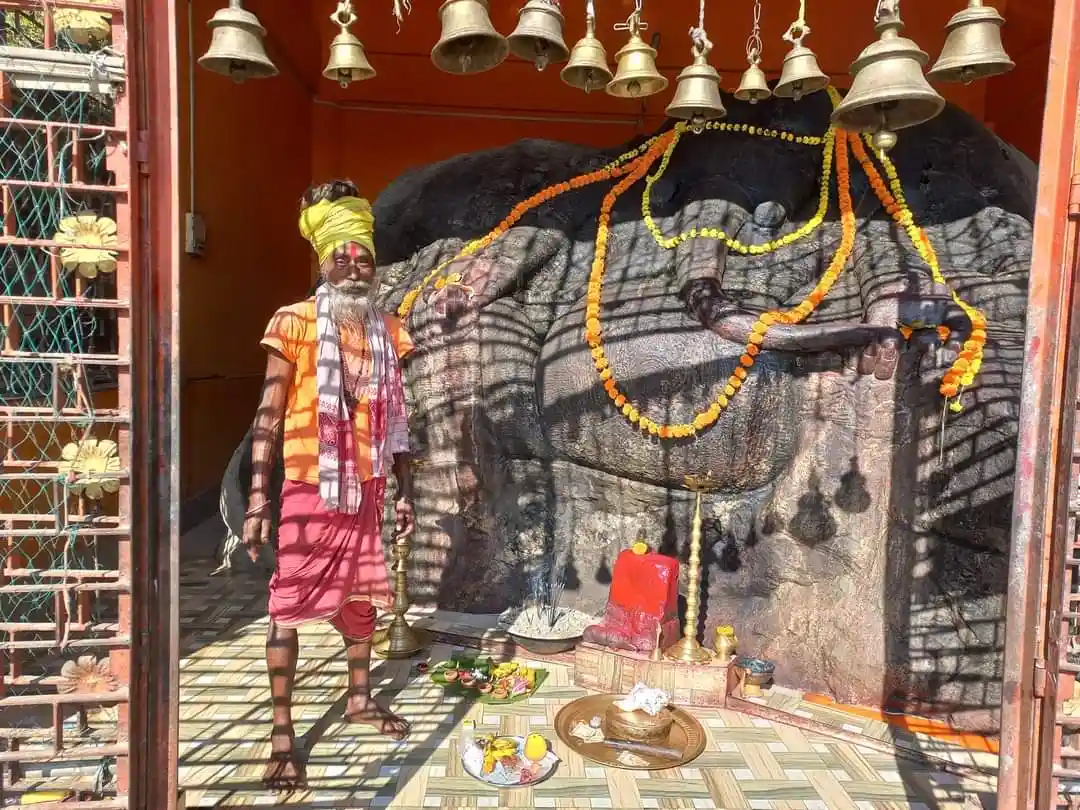The Land of Black Magic
Due to its intriguing history, Mayong is today a famous tourist destination for curious visitors, history buffs, adventure seekers, and those fascinated by magic and witchcraft.

A person using black magic to cure back ache. Image source: The Sentinel Assam
Some of the locals of Mayong still practice black magic and when people visit the place, they offer palm reading. Some even work as fortune-tellers and claim to predict an individual’s future using seashells and broken glass pieces. People from different parts of Assam visit the place to see their fortune and even to ward off evil spells.
Locals believe that the source of their talents and capabilities are passed down by their descendants which comes from the family tree. Previously, the inhabitants of Mayong relied on a traditional practice of medicine for seeking a remedy from a disease. When someone suffers from pox, they would sing “Ainam or Devinam” of any kind, jorani (divine water), bhogsora or prashada, and so on. Other mantras such as Mohini mantra and Bokhikaran mantra, are used to create attraction between two people. According to legends, earlier, people of Mayong could move to wherever they wished in minutes by chanting the Uran mantra, or "flying chant."
The witch doctors/healers of Mayong are often known as bez or ojaa. They don't use medications to treat illness; instead, they chant black magic and are likely assisted by djins. Locals claim that these doctors alleviate pain with copper plates. They place the plate on the injury and chant a few mantras. They believe that the plate “eats away” all the pain and then fall into the ground.
Perhaps one of the most outstanding acts of this method is the act of curing back pain. In the event that a person is in excruciating pain, the plate becomes extremely hot and then break into pieces. Many chronic diseases, according to locals, have been treated in Mayong through black magic.
As absurd as they sound, these tricks have actually been proven. A local resident of Mayong says:
When I was young, one day, all the people of my family having different health
issues gathered and sat together in a room at night. We closed all the doors and windows and lighted some candles. There was an elderly man who sat in between and started reciting some spells and banging the back of two copper plates together very loudly. After a while, we heard these big approaching footsteps. The Joy Kali (Goddess) arrived. From outside, she asked us what’s our problem. We all told her our individual health problems. I told her mine. I had this constant pain in one of my ears. She told me to use the juice of Karna Phul (Flower). Similarly, she advised everyone according to their problems. She addressed everyone as ‘Toi’ (an informal way of addressing) and then went away. Nobody went out that day. The next day, when we went outside, we saw big footprints in our house compound. And I used the remedy and it worked.
Mayong has long been the centre of Indian magic and witchcraft. Narabali or human sacrifice were performed in connection with Shakti worship until the early modern age. Excavators recently discovered swords and other sharp weapons that resembled equipment used for human sacrifice in other parts of India, implying that human sacrifice occurred in Mayong. The Mayong Central Museum and Emporium houses a number of antiques and archaeological relics, as well as books about ancient Ayurveda and black magic.
Close to Mayong, there is the Pobitora Wildlife Sanctuary, which has the highest density of one-horned Rhinoceros. Every year in November, the Mayong Pobitora Festival is held, where one can witness an incredible blend of magic and wildlife.
Earlier people were scared to enter Mayong due to fear of being possessed or having black magic performed on them. But with the advancement of transportation and better communication, people have started exploring the place. Even the inhabitants of Mayong have relocated to other places, and the magic here is primarily used for the welfare of the society. Despite the fact that a lot of things has changed since ancient times, Mayong still remains a secret keeper of magic, myth and lore.
Mayong is also known for its archeological ruins and monuments. A large stone inscription, dating back hundreds of years, can be seen in the hillside village of Burha Mayong. Considered as the largest rock-cut inscriptions in Asia, the contents of the inscriptions are yet to be deciphered and are probably datable to the medieval period.
There are a number of historic temples and shrines as well. The locals call it as the “Land of Pancha Devata” referring to the five Hindu deities – Dinesh, Ganesh, Vishnu, Siva and Shivi (Parvati). The Ganesh Temple at Baha, Mayong is considered the largest Ganesh temple in Assam.

Ganesh Temple at Baha, Mayong

One-horned Rhino at Pobitora Wildlife Sanctuary


